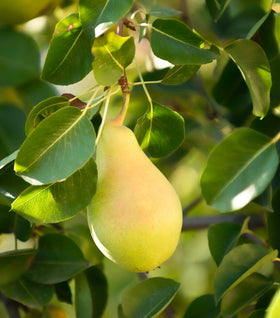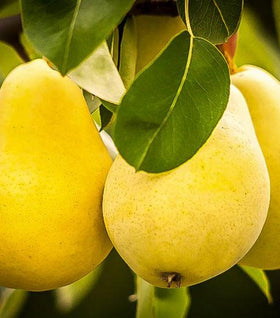Pear Trees For Sale Online
Pears are one of the oldest cultivated fruits in the world, dating back over 5,000 years to Chinese farmers. The fruit of legend, mentioned by Homer in the Odyssey as the "gift of the gods." Pear trees have made their long journey through time from Asia to Europe, finally arriving in America, where it has become one of the most popular and easy to grow fruits for the home orchardist.
Pear Trees are beautiful when in bloom. In fact, some pear trees have been bred not for their fruit but the fabulous flower show in the spring. Fruiting Pear Trees are easy to grow and can be quite productive and rewarding in the home orchard. Pear trees are one of the most upright growing fruit trees, making them perfect for even the smallest yards.
Pears are closely related to Apple Trees, and most of the requirements and care instructions of apples also apply to growing pears. However, Pear trees are less susceptible to the pests and diseases that are commonly experienced with apples. Pears do not ripen on the tree. For the best flavor, allow pears to ripen in a warm, sunny area for several days or until the pear's neck yields to pressure before eating.
When to Plant a Pear Tree
Gardeners throughout the country are recommended to plant tree fruits in the mid to late winter or the spring. This allows the tree to develop a good root system before the growing season. Since most fruit trees sold today, including some bare-root trees, are of a fruiting age developing a sound root system is imperative for fruit set during the same year.
Pear trees can be planted at any time of year, and winter or spring planting is a suggestion rather than a rule.
Choosing a Location for a Pear Tree
Successful cultivation of pear trees in your garden starts with choosing the proper location. If you choose the right spot, the tree will need very little assistance to thrive and provide you with many years of delicious Pears.
Soil: Pears prefer soil that is fertile and well-drained. Choose a site where water does not sit after rain for extended periods. Pear trees should not be planted in extremely dry soil as this can cause drought stress and require frequent watering on the gardener's part. If you live in an area where heavy clay soil or poor drainage is a problem, it is recommended that you amend your existing soil with locally sourced compost, although Pear trees are more forgiving than other fruit-bearing trees and plants.
Proper preparation of the soil will improve your pear tree's performance and promote healthy new growth every year, which will provide you with an abundant crop of pears. If you're concerned about your existing soil, we suggest working with your county or state extension service. They will be able to test your soil and make recommendations based on the findings.
Sunlight: Pear Trees need full sun to grow and produce their best harvest. By definition, full sun is a location that gets at least six to eight hours of sunlight. Proper sunlight is vital for the tree to produce a heavy crop of fruit.
Full sun also has the added benefit of helping to control fungal diseases that can affect Pear trees. Leaf fungus is a problem with Pear trees remaining wet after extended periods of rain and damp spring weather.
How to Plant a Pear Tree
After you've chosen the best location for your pear tree, there are a few easy steps to follow for planting your pear tree. Reminder: Pear trees can be planted at any time of the year as long as the soil can be worked.
Step 1: Water the pear tree thoroughly while it is in the pot. Water until you see the water running out of the bottom of the pot. If you are planting bare-root pear trees, it is recommended to allow the roots to sit in a bucket of water for at least 1 to 2 hours to allow the roots to rehydrate.
Step 2: Dig a hole twice as wide as the pot the tree is growing in. The depth of the hole should be as deep as the root ball, but not deeper. After the pear tree is planted, you should still be able to see the original nursery soil. Planting the tree too deep is the leading cause of poor growth and death of newly planted pear trees.
Step 3: If your existing soil is of poor quality, you should amend the soil with local compost or peat moss at a 50/50 rate. This is also the time to mix in an organic starter fertilizer such as Bio-tone by Espoma.
Step 4: Place the Pear tree in the prepared hole, careful not to overly disturb the roots. It is ok to fluff the roots if the tree is rootbound lightly. This will cause the tree roots to begin to grow out and down rather than circle the root ball.
Step 5: Begin back-filling with the amended soil in 3 to 4-inch layers being careful to tamp the soil between layers. This will remove air pockets and voids created by larger chunks of soil. Be cautious not to damage the existing roots of the tree during this process.
Step 6: Use the leftover soil to create a 3 to 4-inch rim around the planting hole's edges. This will allow water to pool around the newly planted tree and slowly seep into the root zone. Proper watering is essential to the survival of the tree.
We also recommended to mulch the newly planted Pear tree. This helps prevent the sun from drying out the soil and damage the truck from mowing equipment such as string-trimmers.
Watering Pear Trees
Newly planted pear trees should be watered every 2 to 3 days for the first four weeks. After that, begin to cut back on the watering frequency but not the amount of water. When watering, be sure to soak the entire root system. Remember that the root system is usually 18 inches deep on a newly planted tree, and water should absorb all the way through the bottom.
Two of the easiest ways to water newly planted pear trees is to lay the end of the hose at the base of the tree inside the rim and allow it to trickle at the base for 30 to 40 minutes or until you see the water begin to pool.
The second way and our favorite way is to use a Dewitt Dew Right Tree watering bag . Install the bag at the base of the Pear Tree and fill it with water. Water is allowed to slowly drain from the bag providing the perfect amount of water to the root zone.
Pruning of Apple Trees
Pruning Pear Trees can seem like a daunting task, but you will find it an enjoyable and fulfilling task once you do it the first time.
Pruning pear trees should take place during the dormant season. The ideal time is in the late winter before the tree begins to wake up and begin growing. Pruning stimulates the tree and will make it stronger and more fruitful.
By reducing the branches' overall length, the tree will support a heavy crop of pears and not risk the branches breaking under the weight of the crop. The fruits grown on a properly pruned pear tree will be larger and more colorful. Many of the new medium-sized to semi-dwarf trees have shorter branches, meaning that the crop's weight will be less of a problem, and you likely can skip pruning.


